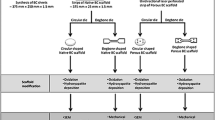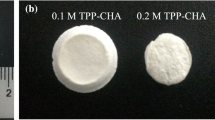Abstract
Highly porous and interconnected scaffolds were fabricated using calcium phosphate glass (CPG) for bone tissue engineering. An avidin–biotin binding system was used to improve osteoblast-like cell adhesion to the scaffold. The scaffolds had open macro- and micro-scale pores, and continuous struts without cracks or defects. Scaffolds prepared using a mixture (amorphous and crystalline CPG) were stronger than amorphous group and crystalline group. Cell adhesion assays showed that more cells adhered, with increasing cell seeding efficiency to the avidin-adsorbed scaffolds, and that cell attachment to the highly porous scaffolds significantly differed between avidin-adsorbed scaffolds and other scaffolds. Proliferation was also significantly higher for avidin-adsorbed scaffolds. Osteoblastic differentiation of MG-63 cells was observed at 3 days, and MG-63 cells in direct contact with avidin-adsorbed scaffolds were positive for type I collagen, osteopontin, and alkaline phosphatase gene expression. Osteocalcin expression was observed in the avidin-adsorbed scaffolds at 7 days, indicating that cell differentiation in avidin-adsorbed scaffolds occurred faster than the other scaffolds. Thus, these CPG scaffolds have excellent biological properties suitable for use in bone tissue engineering.







Similar content being viewed by others
References
Anamelechi, C. C., G. A. Truskey, and W. M. Reichert. Mylar (TM) and Teflon-AF (TM) as cell culture substrates for studying endothelial cell adhesion. Biomaterials 26(34):6887–6896, 2005.
Andrade, J. D., and V. Hlady. Protein adsorption and materials biocompatibility—a tutorial review and suggested hypotheses. Adv. Polym. Sci. 79:1–63, 1986.
Aubin, J. E., F. Liu, L. Malaval, and A. K. Gupta. Osteoblast and chondroblast differentiation. Bone 17(2):S77–S83, 1995.
Barriga, A., P. Diaz-de-Rada, J. L. Barroso, M. Alfonso, M. Lamata, S. Hernaez, J. L. Beguiristain, M. San-Julian, and C. Villas. Frozen cancellous bone allografts: positive cultures of implanted grafts in posterior fusions of the spine. Eur. Spine J. 13(2):152–156, 2004.
Bhat, V. D., B. Klitzman, K. Koger, G. A. Truskey, and W. M. Reichert. Improving endothelial cell adhesion to vascular graft surfaces: clinical need and strategies. J. Biomater. Sci. Polym. E 9(11):1117–1135, 1998.
Bogdanov, A. A., L. V. Gordeeva, B. A. Baibakov, L. B. Margolis, and V. P. Torchilin. Restoration of adhesive potentials of ehrlich ascites-carcinoma cells by modification of plasma-membrane. J. Cell. Physiol. 147(1):182–190, 1991.
Brauer, D. S., C. Russel, S. Vogt, J. Weisser, and M. Schnabelrauch. Fabrication and in vitro characterization of porous biodegradable composites based on phosphate glasses and oligolactide-containing polymer networks. J. Biomed. Mater. Res. A 80A(2):410–420, 2007.
Chen, R., and J. A. Hunt. Biomimetic materials processing for tissue-engineering processes. J. Mater. Chem. 17(38):3974–3979, 2007.
Choquet, D., D. P. Felsenfeld, and M. P. Sheetz. Extracellular matrix rigidity causes strengthening of integrin-cytoskeleton linkages. Cell 88(1):39–48, 1997.
Faull, R. J., N. L. Kovach, J. M. Harlan, and M. H. Ginsberg. Affinity modulation of integrin alpha-5-beta-1—regulation of the functional-response by soluble fibronectin. J. Cell Biol. 121(1):155–162, 1993.
Goulet, J. A., L. E. Senunas, G. L. DeSilva, and M. L. Greenfield. Autogenous iliac crest bone graft. Complications and functional assessment. Clin. Orthop. Relat. Res. 339:76–81, 1997.
Hing, K. A., L. E. Wilson, and T. Buckland. Comparative performance of three ceramic bone graft substitutes. Spine J. 7(4):475–490, 2007.
Hong, M. H., S. M. Kim, K. M. Kim, and Y. K. Lee. Development and in vitro assays of porous calcium polyphosphate granules. Ceram. Int. 39(5):4991–4997, 2013.
Hong, M. H., S. M. Kim, J. Y. Om, N. Kwon, and Y. K. Lee. Seeding cells on calcium phosphate scaffolds using hydrogel enhanced osteoblast proliferation and differentiation. Ann. Biomed. Eng. 42(7):1424–1435, 2014.
Hynes, R. O. Integrins—versatility, modulation, and signaling in cell-adhesion. Cell 69(1):11–25, 1992.
Ishaug, S. L., G. M. Crane, M. J. Miller, A. W. Yasko, M. J. Yaszemski, and A. G. Mikos. Bone formation by three-dimensional stromal osteoblast culture in biodegradable polymer scaffolds. J. Biomed. Mater. Res. 36(1):17–28, 1997.
Ishaug-Riley, S. L., G. M. Crane-Kruger, M. J. Yaszemski, and A. G. Mikos. Three-dimensional culture of rat calvarial osteoblasts in porous biodegradable polymers. Biomaterials 19(15):1405–1412, 1998.
Karageorgiou, V., and D. Kaplan. Porosity of 3D biomaterial scaffolds and osteogenesis. Biomaterials 26(27):5474–5491, 2005.
Kasuga, T. Bioactive calcium pyrophosphate glasses and glass-ceramics. Acta Biomater. 1(1):55–64, 2005.
Kim, M. C., B. H. Lee, K. N. Kim, K. M. Kim, and Y. K. Lee. Relation between structure and mechanical properties of porous scaffold using calcium phosphate glass–ceramics. Korean J. Dent. Mater. 37(3):211–217, 2010.
Kim, T., C. Hwang, D. Gwoo, H. Park, and B. K. Ryu. Effects of substitution of K2O for Na2O on the bioactivity of CaO-Na2O-SiO2-P2O5 glasses. Electron. Mater. Lett. 8(5):541–544, 2012.
Kojima, N., T. Matsuo, and Y. Sakai. Rapid hepatic cell attachment onto biodegradable polymer surfaces without toxicity using an avidin–biotin binding system. Biomaterials 27(28):4904–4910, 2006.
Langer, R., and J. P. Vacanti. Tissue engineering. Science 260(5110):920–926, 1993.
Lian, J. B., and G. S. Stein. Concepts of osteoblast growth and differentiation—basis for modulation of bone cell-development and tissue formation. Crit. Rev. Oral Biol. Med. 3(3):269–305, 1992.
Lincks, J., B. D. Boyan, C. R. Blanchard, C. H. Lohmann, Y. Liu, D. L. Cochran, D. D. Dean, and Z. Schwartz. Response of MG63 osteoblast-like cells to titanium and titanium alloy is dependent on surface roughness and composition. Biomaterials 19(23):2219–2232, 1998.
Ma, P. X. Scaffolds for tissue fabrication. Mater. Today 7(5):30–40, 2004.
Navarro, M., S. del Valle, S. Martinez, S. Zeppetelli, L. Ambrosio, J. A. Planell, and M. P. Ginebra. New macroporous calcium phosphate glass ceramic for guided bone regeneration. Biomaterials 25(18):4233–4241, 2004.
Tsai, W. B., and M. C. Wang. Effect of an avidin–biotin binding system on chondrocyte adhesion, growth and gene expression. Biomaterials 26(16):3141–3151, 2005.
Vacanti, J. P., and C. A. Vacanti. Chapter 1—The history and scope of tissue engineering. In: Principles of Tissue Engineering 4th, edited by R. Lanza, R. Langer, and J. Vacanti. Boston: Academic Press, 2014, pp. 3–8.
Acknowledgements
This work was supported by the National Research Foundation of Korea (NRF) grant funded by the Korea government MSIP (No. 2008-0062283). This work was supported by the National Research Foundation of Korea (NRF) grant funded by the Korea government (MSIP) (No. 2014M3A7B4051594). This work was supported (in part) by the Yonsei University Yonsei-SNU Collaborative Research Fund of 2014.
Author information
Authors and Affiliations
Corresponding author
Additional information
Associate Editor Jane Grande-Allen oversaw the review of this article.
Min-Chul Kim and Min-Ho Hong have contributed equally to this work.
Rights and permissions
About this article
Cite this article
Kim, MC., Hong, MH., Lee, BH. et al. Bone Tissue Engineering by Using Calcium Phosphate Glass Scaffolds and the Avidin–Biotin Binding System. Ann Biomed Eng 43, 3004–3014 (2015). https://doi.org/10.1007/s10439-015-1347-y
Received:
Accepted:
Published:
Issue Date:
DOI: https://doi.org/10.1007/s10439-015-1347-y




